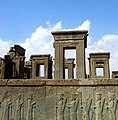Aĥemenida Imperio
| Aĥemenida Imperio | |||||||||||||||
| |||||||||||||||
| historia lando • historia epoko | |||||||||||||||
|---|---|---|---|---|---|---|---|---|---|---|---|---|---|---|---|
Geografio
| |||||||||||||||
| Ĉefurbo: | |||||||||||||||
| Loĝantaro | |||||||||||||||
Kvanto de loĝantoj:
|
17 000 000
| ||||||||||||||
Zaratuŝtrismo • mezopotamia religio • judismo • religio de antikva Egiptio • religio en Antikva Grekio
| |||||||||||||||
| Ŝtat-strukturo | |||||||||||||||
darkemono • siglos
| |||||||||||||||
| |||||||||||||||
La Aĥemenida Imperio; en la malnovpersa lingvo: Pārsa;[1][2] en la novpersa: شاهنشاهی هخامنشی, aŭ Unua Persa Imperio,[3] estis imperio bazita en Okcidenta Azio nome en Irano, fondita en la 6-a jarcento a.K.: fare de Ciro la Granda,[3] kiu regis grandan parton de okcidenta Azio (kaj dumtempe ankaŭ partojn de Eŭropo kaj Afriko) de la jaroj 550 ĝis 330 antaŭ nia erao. La dinastio ŝuldas sian nomon el la reĝo Aĥemeno, kiu regis en Persis inter 705 a.K. kaj 675 a.K. La imperio etendiĝis por eventuale regadi super gravaj partoj de la antikva mondo, kiuj ĉirkaŭ la jaro 500 a.K. etendis el partoj de Balkanio (Bulgario-Panonio) kaj Trakio-Makedonio okcidente, al Indusa Valo oriente, kio faris ĝin la plej granda imperio el la ĝistiama mondo.[4] La Aĥemenida Imperio eventuale kontrolis ankaŭ Egiption. Ĝi estis regata de serio de monarkoj kiuj unuigis ties separatajn tribojn kaj naciecojn per konstruado de kompleksa vojreto.
Bildaro
[redakti | redakti fonton]-
Panoramo de la ruinoj de Persepolis
-
Ruinoj de la Tronejo
-
Apadana, Persaj kaj Medaj soldatoj ĉe Persepolis
-
Nowruz Zoroastro
Referencoj
[redakti | redakti fonton]- ↑ Arkivita kopio. Arkivita el la originalo je 2016-02-18. Alirita 2014-10-19 .
- ↑ http://www.fas.harvard.edu/~iranian/OldPersian/OPers5_End.pdf
- ↑ 3,0 3,1 Sampson, Gareth C.. (2008) The Defeat of Rome: Crassus, Carrhae and the Invasion of the East. Pen & Sword Books Limited. ISBN 9781844156764. “Cyrus the Great, founder of the First Persian Empire (c. 550–330 BC).”.
- ↑ David Sacks, Oswyn Murray, Lisa R. Brody. (2005) Encyclopedia of the ancient Greek world. Infobase Publishing, p. 256 (dekstre de la ). ISBN 978-0-8160-5722-1.
Literaturo
[redakti | redakti fonton]- Briant, Pierre. "Alexander". Encyclopaedia Iranica. vol. 3. Londono: eldonejo Routledge & Kegan Paul. [1] Arkivigite je 2008-05-17 per la retarkivo Wayback Machine
- A. Sh. Shahbazi. ARIARAMNEIA. vol. 2. Encyclopaedia Iranica (Routledge & Kegan Paul). [2]
- Schmitt, Rüdiger. "Achaemenid dynasty". Encyclopaedia Iranica. vol. 3. Routledge & Kegan Paul. [3] Arkivigite je 2009-03-17 per la retarkivo Wayback Machine
- Schlerath, Bernfried (1973). Die Indogermanen. Inst. f. Vergl. Sprachwiss. ISBN 3-85124-516-4.
- Tavernier, Jan (2007). Iranica in the Achaemenid Period (ca. 550-330 B.C.): Linguistic Study of Old Iranian Proper Names and Loanwords, Attested in Non-Iranian Texts. Peeters Publishers. ISBN 90-429-1833-0.
- Stronach, David "Darius at Pasargadae: A Neglected Source for the History of Early Persia," Topoi
- Stronach, David "Anshan and Parsa: Early Achaemenid History, Art and Architecture on the Iranian Plateau". In: John Curtis, ed., Mesopotamia and Iran in the Persian Period: Conquest and Imperialism 539–331, 35–53. Londono: British Museum Press 1997.
- Wiesehöfer, Josef. "History in pre-Islamic period". Encyclopaedia Iranica. [4][rompita ligilo]
- Wiesehöfer, Josef. (2001) Ancient Persia. London, New York: I.B. Tauris. ISBN 1-86064-675-1.
There have been a number of editions since 1996.
- Curtis, John E.. (2005) Forgotten Empire: The World of Ancient Persia. Berkeley and Los Angeles: University of California Press. ISBN 0-520-24731-0.
A collection of articles by different authors.
- Pierre Briant. (January 2002) From Cyrus to Alexander: a history of the Persian Empire. ISBN 978-1-57506-031-6.
- The Greco-Persian Wars, Peter Green
- Philip Souza. (2003-01-25) The Greek and Persian Wars 499-386 BC. Osprey Publishing. ISBN 978-1-84176-358-3.
- The Heritage of Persia, Richard N. Frye
- History of the Persian Empire, A.T. Olmstead
- The Persian Empire, Lindsay Allen
- The Persian Empire, J.M. Cook
- Persian Fire: The First World Empire and the Battle for the West, Tom Holland
- Pictorial History of Iran: Ancient Persia Before Islam 15000 B.C.–625 A.D., Amini Sam
- Timelife Persians: Masters of the Empire (Lost Civilizations)
- M. A. Dandamaev. (1989) A Political History of the Achaemenid Empire. Brill Academic Pub. ISBN 978-90-04-09172-6.
- Hallock, R., Persepolis Fortification Tablets Arkivigite je 2007-06-21 per la retarkivo Wayback Machine
- Chopra, R.M., artikolo pri "A Brief Review of Pre-Islamic Splendour of Iran", INDO-IRANICA, Vol.56 (1-4), 2003.
Vidu ankaŭ
[redakti | redakti fonton]Eksteraj ligiloj
[redakti | redakti fonton]- Persia Historio
- Livius.org ĉe Achaemenids
- Swedish Contributions to the Archaeology of Iran Arkivigite je 2021-07-22 per la retarkivo Wayback Machine Artikel i Fornvännen (2007) de Carl Nylander
- ČIŠPIŠ
- The Behistun Inscription Arkivigite je 2007-05-10 per la retarkivo Wayback Machine
- Livius.org on Achaemenid Royal Inscriptions Arkivigite je 2016-12-18 per la retarkivo Wayback Machine
- Achaemenid art on Iran Chamber Society (www.iranchamber.com)
- Persepolis Fortification Archive Project
- Photos of the tribute bearers from the 23 satrapies of the Achaemenid empire, from Persepolis Arkivigite je 2021-08-31 per la retarkivo Wayback Machine
- medals and orders of the Persian empire[rompita ligilo]
- Ancient Iran Arkivigite je 2012-10-23 per la retarkivo Wayback Machine
- Dynasty Achaemenid Arkivigite je 2010-05-02 per la retarkivo Wayback Machine
- Iran, The Forgotten Glory – Documentary Film About Ancient Iran (achaemenids & Sassanids) Arkivigite je 2010-04-28 per la retarkivo Wayback Machine
- Achemenet The major electronic resource for the study of the history, literature and archaeology of the Persian Empire
- Persepolis Before Incursion (Virtual tour project)









